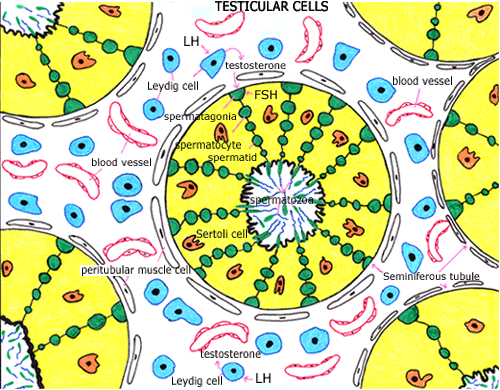|

The control of the male reproductive system is similar in many ways to the control of the female reproductive system. In the male system, the hypothalamus releases a hormone called GnRH that stimulates the pituitary gland to release FSH and LH. These pituitary hormones (FSH and LH) then bind specific receptors on cells within the testes to trigger a biologic response.
The testes contain a number of different types of cells that coordinate their activities so as to produce mature (functional) sperm cells.
Gonocytes in a testis are (pre-sperm) cells that are able to divide repeatedly to increase their own number, thereby providing a continuous and lifelong source of new sperm precursor cells. This means that men do not generally “run out” of sperm as they age (so they remain fertile throughout their lives).
Gonocytes may differentiate (specialize) into sperm cells, which then mature from spermatogonia into spermatozoa. Sperm cells are initially contained within (and develop within) a series of tubules in the testes called “seminiferous tubules.” As the sperm cells mature (from spermatogonia to spermatocyte to spermatid to spermatozoa), they move within the wall of the seminiferous tubule between the Sertoli cells toward a central lumen.
Sertoli cells are contained within the seminiferous tubules. At puberty, FSH and Testosterone act on the Sertoli cells to initiate spermatogenesis (sperm maturation).
Leydig cells are contained in the testicular tissue that exists between seminiferous tubules. Testosterone is produced by the Leydig cells in response to LH (from the pituitary gland). This testosterone then acts (along with pituitary FSH) on the Sertoli cells within the seminiferous tubules to produce mature spermatozoa.
|

|